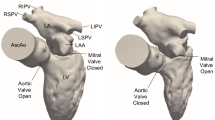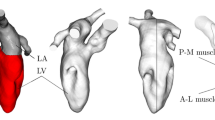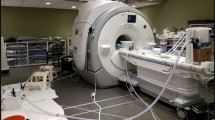Abstract
Recent developments in medical image acquisition combined with the latest advancements in numerical methods for solving the Navier-Stokes equations have created unprecedented opportunities for developing simple and reliable computational fluid dynamics (CFD) tools for meeting patient-specific surgical planning objectives. However, for CFD to reach its full potential and gain the trust and confidence of medical practitioners, physics-driven numerical modeling is required. This study reports on the experience gained from an ongoing integrated CFD modeling effort aimed at developing an advanced numerical simulation tool capable of accurately predicting flow characteristics in an anatomically correct total cavopulmonary connection (TCPC). An anatomical intra-atrial TCPC model is reconstructed from a stack of magnetic resonance (MR) images acquired in vivo. An exact replica of the computational geometry was built using transparent rapid prototyping. Following the same approach as in earlier studies on idealized models, flow structures, pressure drops, and energy losses were assessed both numerically and experimentally, then compared. Numerical studies were performed with both a first-order accurate commercial software and a recently developed, second-order accurate, in-house flow solver. The commercial CFD model could, with reasonable accuracy, capture global flow quantities of interest such as control volume power losses and pressure drops and time-averaged flow patterns. However, for steady inflow conditions, both flow visualization experiments and particle image velocimetry (PIV) measurements revealed unsteady, complex, and highly 3D flow structures, which could not be captured by this numerical model with the available computational resources and additional modeling efforts that are described. Preliminary time-accurate computations with the in-house flow solver were shown to capture for the first time these complex flow features and yielded solutions in good agreement with the experimental observations. Flow fields obtained were similar for the studied total cardiac output range (1–3 l/min); however hydrodynamic power loss increased dramatically with increasing cardiac output, suggesting significant energy demand at exercise conditions. The simulation of cardiovascular flows poses a formidable challenge to even the most advanced CFD tools currently available. A successful prediction requires a two-pronged, physics-based approach, which integrates high-resolution CFD tools and high-resolution laboratory measurements.
Similar content being viewed by others
References
August, A. D., D. C. Barratt, A. D. Hughes, F. P. Glor, T. SAMcG, and X. Y. Xu. Accuracy and reproducibility of CFD predicted wall shear stress using 3D ultrasound images. J. Biomech. Eng. 125:218–22, 2003.
Bale-Glickman, J., K. Selby, D. Saloner, and Ö. Savas. Experimental flow studies in exact-replica phantoms of atherosclerotic carotid bifurcations under steady input conditions. J. Biomech. Eng. 125:38-48, 2003.
Bolzon, G., G. Pedrizzetti, M. Grigioni, L. Zovatto, C. Daniele, and G. D’Avenio. Flow on the symmetry plane of a total cavo-pulmonary connection, J. Biomech. 35:595–608, 2002.
Cebral, J. R., P. J. Yim, R. Lo, O. Soto, and P. L. Choyke. Blood flow modeling in carotid arteries with computational fluid dynamics and MR imaging. Acad. Radiol. 9:1286–1299, 2002.
Celik, I., C. J. Chen, P. J. Roache, and G. Scheuerer (editors). Symposium on quantification of uncertainty in computational fluid dynamics. In: Proceedings of ASME Fluids Engineering Division, Washington, DC, 1993.
Cochrane, A. D., C. P. Brizard, D. J. Penny, S. Johansson, J. V. Comas, T. Malm, and T. R. Karl. Management of the univentricular connection: are we improving? Eur. J. Cardiothorac. Surg. 12:107–115, 1997.
Coleman, H. W. Some observations on uncertainties and the verification and validation of a simulation. J. Fluids Eng. 125:733–735, 2003.
de Laval, M. R., P. Kilner, M. Gewillig, and C. Bull. Total cavopulmonary connection: A logical alternative to atriopulmonary connection for complex Fontan operations. Experimental studies and early clinical experience. J. Thorac. Cardiovasc. Surg. 96:682–695, 1988.
DeGroff, C. G., B. L. Thornburg, J. O. Pentecost, K. L. Thornburg, M. Gharib, D. J. Sahn, and A. Babtista. Flow in the early embryonic human heart: A numerical study. Pediatr. Cardiol. 24:375–380, 2003.
Ensley, A. E., A. Ramuzat, T. M. Healy, G. P. Chatzimavroudis, C. Lucas, S. Sharma, R. Pettigrew, and A. P. Yoganathan. Fluid mechanic assessment of the total cavopulmonary connection using magnetic resonance phase velocity mapping and digital particle image velocimetry. Ann. Biomed. Eng. 28:1172–1183, 2000.
Ensley, A. E., P. Lynch, G. P. Chatzimavroudis, C. Lucas, S. Sharma, and A. P. Yoganathan. Toward designing the optimal total cavopulmonary connection: An in vitro study. Ann. Thorac. Surg. 68:1384–1390, 1999.
Farhat, C., S. Lanteri, and H. D. Simon. TOP/DOMEC A software tool for mesh partitioning and parallel processing. J. Comput. Sys. Eng. 6:13–26, 1995.
Fogel, M. A., A. Hubbard, and P. M. Weinberg. A simplified approach for assessment of intercardiac baffles and extracardiac conduits in congenital heart surgery with two- and three-dimensional magnetic resonance imaging. Am. Heart J. 142(6):1028–1036, 2001.
Fogel, M. A., P. M. Weinberg, J. Rychik, A. Hubbard, M. Jacobs, T. L. Spray, and J. Haselgrove. Caval contribution to flow in the branch pulmonary arteries of Fontan patients with a novel application of magnetic resonance presaturation pulse. Circulation 99:1215–1221, 1999.
Formaggia, L., F. Nobile, A. Quarteroni, and A. Veneziani. Multiscale modelling of the circulatory system: A preliminary analysis. Comput. Visual Sci. 2:75–83, 1999.
Frakes, D., C. Conrad, T. Healy, J. Monaco, M. Smith, M. Fogel, S. Sharma, and A. P. Yoganathan. Application of an adaptive control grid interpolation technique to morphological vascular reconstruction. IEEE Trans. Bio. Eng. 50(2):197–206, 2003.
Frakes, D., M. Smith, D. de Zélicourt, K. Pekkan, A. Yoganathan. Three-dimensional velocity field reconstruction. J. Biomech. Eng. 126(6):727–735, 2004.
Frakes, D., M. Fogel, J. Parks, S. Sharma, M. J. T. Smith, and A. P. Yoganathan. MRI-based 3D modeling of cardiac vascular anatomies for surgical applications. In: Proceedings of the American College of Cardiology Annual Scientific Session 2004, New Orleans, LA, March 2004.
Freitas, C. J. Journal of fluids engineering editorial policy statement on the control of numerical accuracy. J. Fluids Eng. 115:339–340, 1993.
Freitas, C. J. Perspective: Selected benchmarks from commercial CFD codes. J. Fluids Eng. 117(2):208–218, 1995.
Freitas, C. J. The issue of numerical uncertainty. Appl. Math. Model. 26:237–248, 2002.
Friesen, C. L. H., and J. M. Forbess. Surgical management of the single ventricle. Prog Pediatr. Cardiol. 16:47–68, 2002.
Ge, L., S. C. Jones, F. Sotiropoulos, T. M. Healy, and A. P. Yoganathan. Numerical simulation of flow in mechanical heart valves: Grid resolution and the assumption of flow symmetry. J. Biomech. Eng. 125(5):709–718, 2003.
Geva, T., D. J. Sahn, and A. J. Powell. Magnetic resonance imaging of congenital heart disease in adults. Prog. Pediatr. Cardiol. 17:21–39, 2003.
Guadagni, G., E. L. Bove, F. Migliavacca, and G. Dubini. Effects of pulmonary afterload on the hemodynamics after the hemi-Fontan procedure. Med. Eng. Phys. 23:293–298, 2001.
Guide for the Verification and Validation of Computational Fluid Dynamics Simulations. American Institute of Aeronautics and Astronautics (AIAA), 1998, G-077-1998.
Haas, G. S., H. Hess, M. Black, J. Onnasch, F. W. Mohr, and J. A. M. van Son. Extracardiac conduit Fontan procedure: Early and intermediate results. Eur. J. Cardiothorac. Surg. 17:648–654, 2000.
Haroutunian, V., M. S. Engelman, and I. Hasbani. Segregated finite element algorithms for the numerical solution of large-scale incompressible flow problems. Int. J. Numer. Methods Fluids 17:323–348, 1993.
Healy, T. M., C. Lucas, and A. P. Yoganathan. Noninvasive fluid dynamic power loss assessments for total cavopulmonary connections using the viscous dissipation function: A feasibility study. J. Biomech. Eng. 123:317–324, 2001.
Hjortdal, V. E., K. Emmertsen, E. Stenbog, T. Frund, M. R. Schmidt, O. Kromann, K. Sorensen, and E. M. Pedersen. Effects of exercise and respiration on blood flow in total cavopulmonary connection. A real-time magnetic resonance flow study. Circulation 108:1227–1231, 2003.
Hughes, T. R. J., and A. N. Brooks. A multidimensional upwind scheme with no crosswind diffusion. In: Finite Element Methods for Convection Dominated Flows, edited by T. J. R. Hughes. ASME Press, New York, 1979, pp. 19–35.
Hughes, T. R. J., L. P. Franca, and M. Becestra. A new finite element formulation for computational fluid dynamics, V. Circumventing the Babuska-Brezzi conduction, A stable Petrov-Galerkin formulation of the Stokes problem accommodating equal-order interpolations. Comp. Meth. Appl. Mech. Eng. 59:85–99, 1986.
California Institute of Technology. In: Proceedings of the International Biofluid Mechanics Conference, organized by S. Einav, R. Ethier, M. Gharib, R. Kamm, D. Liepsch, and A. P. Yoganathan. California Institute of Technology, December 12–14, 2003.
Iordanis, C., V. D. Butty, V. B. Makhijani, D. Poulikakos, and Y. Ventikos. Pulsatile blood flow in anatomically accurate vessels with multiple aneurysms: A medical intervention planning application of computational haemodynamics. Flow Turbul. Combust. 71:333–346, 2003.
Jacobs, P. Stereolithography and Other RP&M Technologies. ASME Press, New York, 1996.
Johnston, B. M., P. R. Johnston, S. Corney, and D. Kilpatrick. Non-Newtonian blood flow in human right coronary arteries: Steady state simulations. J. Biomech. 37(5):709–720, 2004.
Karypis, G., and V. Kumar. MeTIS—A Software Package for Partitioning Unstructured Graphs, Partitioning Meshes and Computing Fill-Reducing Orderings of Sparse Matrices (Version 3.0). Minnesota: University of Minnesota, Department of Computer Science/Army HPC research center, October 1997.
Khunatron, Y., R. Shandas, C. DeGroff, and S. Mahalingam. Comparison of in vitro velocity measurements in a scaled total cavopulmonary connection with computational predictions. Ann. Biomed. Eng. 31:810–822, 2003.
Kim, Y. H., P. G. Walker, A. A. Fontaine, S. Panchal, A. E. Ensley, J. Oshinski, S. Sharma, B. Ha, C. L. Lucas, and A. P. Yoganathan. Hemodynamics of the Fontan connection: An in vitro study. J. Biomech. Eng. 117:423–428, 1995.
Ku, J. P., M. T. Draney, F. R. Arko, W. A. Lee, F. P. Chan, N. J. Pelc, C. K. Zarins, and C. A. Taylor. In vivo validation of numerical prediction of blood flow in arterial bypass grafts. Ann. Biomed. Eng. 30:743–752, 2002.
Laccarino, G. Predictions of a turbulent separated flow using commercial CFD codes. J. Fluids Eng. 123:819–828, 2001.
Liu, Y., K. Pekkan, S. C. Jones, and A. P. Yoganathan. The effects of different mesh generation methods on fluid dynamic analysis and power loss in total cavopulmonary connection (TCPC). J. Biomech. Eng. 126(5):594–603, 2004.
Masters, J. C., M. Ketner, M. S. Bleiweis, M. Mill, A. P. Yoganathan, and C. L. Lucas. The effect of incorporating vessel compliance in a computational model of blood flow in a total cavopulmonary connection (TCPC) with caval offset. J. Biomech. Eng. 2002.
Metcalfe, R. W. The promise of computational fluid dynamics as a tool for delineating therapeutic options in the treatment of aneurysms. AJNR Am. J. Neuroradiol. 24:553–554, 2003.
Migliavacca, F., G. Dubini, E. L. Bove, and M. R. de Leval. Computational fluid dynamics simulations in realistic 3-D geometries of the total cavopulmonary anastomosis: The influence of the inferior caval anastomosis. J. Biomech. Eng. 125:805–813, 2003.
Migliavacca, F., P. J. Kilner, G. Pennati, G. Dubini, R. Pietrabissa, R. Fumero, and M. R. de Leval. Computational fluid dynamic and magnetic resonance analyses of flow distribution between the lungs after total cavopulmonary connection. IEEE Trans. Bio. Eng. 46(4):393–399, 1999.
Moore, J. A., D. A. Steinman, S. Prakash, K. W. Johnston, and C. R. Either. A numerical study of blood flow patterns in anatomically realistic and simplified end-to-side anastomoses. J. Biomech. Eng. 121:265–272, 1999.
Nowak, N., P. P. Kakade, and A. V. Annapragada. Computational fluid dynamics simulation of airflow and aerosol deposition in human lungs. Ann. Biomed. Eng. 31:374–390, 2003.
Oshima, M., R. Torii, T. Kobayashi, N. Taniguchi, and K. Takagi. Finite element simulation of blood flow in the cerebral artery. Comput. Methods Appl. Mech. Eng. 191:661–671, 2001.
Pekkan, K., D. A. de Zélicourt, and A. P. Yoganathan. In vitro flow visualization of a post-surgery total cavopulmonary connection anatomy, 21st Annual Gallery of Fluid Motion (movie). In: Proceedings of the Applied Physical Society Division of Fluid Dynamics 56th Annual Meeting, 2003.
Perot, B. Conservation properties of unstructured staggered mesh schemes. J. Comput. Phys. 159(1):58–59, 2000.
Roache, P. J. Verification and Validation in Computational Science and Engineering. Albuquerque, New Mexico: Hermosa publishers, 1998.
Ryu, K., T. M. Healy, A. E. Ensley, S. Sharma, C. L. Lucas, and A. P. Yoganathan. Importance of accurate geometry in the study of the total cavopulmonary connection: Computational simulations and in vitro experiments. Ann. Biomed. Eng. 29:844–853, 2001.
Saber, N. R., A. D. Gosman, N. B. Wood, P. J. Kilner, C. L. Charrier, and D. N. Firmin. Computational flow modeling of the left ventricle based on in vivo MRI data: Initial experience. Ann. Biomed. Eng. 29:275–283, 2001.
Shahcheraghi, N., H. A. Dwyer, A. Y. Cheer, A. I. Barakat, and T. Rutaganira. Unsteady and three-dimensional simulation of blood flow in the human aortic arch. J. Biomech. Eng. 124:378–397, 2002.
Sharma, S., A. E. Ensley, K. Hopkins, G. P. Chatzimavroudis, T. M. Healy, V. H. K. Tam, K. R. Kanter, and A. P. Yoganathan. In vivo flow dynamics of the total cavopulmonary connection from three-dimensional multi slice magnetic resonance imaging. Ann. Thorac. Surg. 71:889–898, 2001.
Sheu, T. W. H., S. F. Tsai, W. S. Hwang, and T. M. Chang. A finite element study of the blood flow in total cavopulmonary connection. Comput. Fluids 28:19–39, 1999.
Special issue on verification and validation in CFD. AIAA J. 36(5), 1998.
Swann, S. Integration of MRI and stereolithography to build medical models: A case study. Rapid Prototyp. J. 2(4):41–46, 1996.
Tang, H. S., S. C. Jones, and F. Sotiropoulos. An overset-grid method for 3D unsteady incompressible flows. J. Comput. Phys. 191(2):567–600, 2003.
Thomas, J. B., J. S. Milner, B. K. Rutt, and D. A. Steinman. Reproducibility of image-based computational fluid dynamics models of the human carotid bifurcation. Ann. Biomed. Eng. 31:132–41, 2003.
NATO Advisory Group for Aeronautical Research and Development. Validation of Computational Fluid Dynamics. Portugal: NATO Advisory Group for Aeronautical Research and Development, AGARD CP 437, December 1988.
Van Haesdonck, J. M., L. Mertens, R. Sizaire, G. Montas, B. Purnode, W. Daenen, M. Crochet, and M. Gewling. Comparisons by computerized numeric modeling of energy losses in different Fontan connections. Circulation 92:322–326, 1995.
Verdonck, P. Guest Editorial, The role of computational fluid dynamics for artificial organ design. Artif. Organs 26(7):569–570, 2002.
Workshop, British Heart Foundation, Imperial College, London: Breaking Symmetry in Haemodynamics. Biorheology (Special Issue), 39(3–4):289–575, 2001.
Yedavalli, R. V., F. Loth, A. Yardimci, W. F. Pritchard, J. N. Oshinski, L. Sadler, F. Charbel, and N. Alperin. Construction of a physical model of the human carotid artery based upon in vivo magnetic resonance images. J. Biomech. Eng. 123:372–376, 2001.
Zhang, X., D., Schimdt, and B. Perot. Accuracy and conservation properties of a three-dimensional unstructured staggered mesh scheme for fluid dynamics. J. Comput. Phys. 175(2):764–791, 2002.
Author information
Authors and Affiliations
Corresponding author
Rights and permissions
About this article
Cite this article
Pekkan, K., Zélicourt, D., Ge, L. et al. Physics-Driven CFD Modeling of Complex Anatomical Cardiovascular Flows—A TCPC Case Study. Ann Biomed Eng 33, 284–300 (2005). https://doi.org/10.1007/s10439-005-1731-0
Received:
Accepted:
Issue Date:
DOI: https://doi.org/10.1007/s10439-005-1731-0




